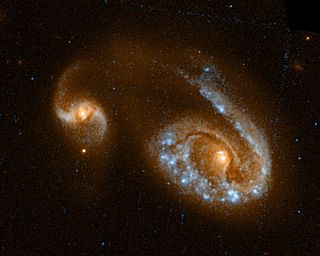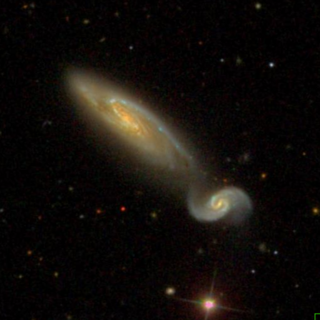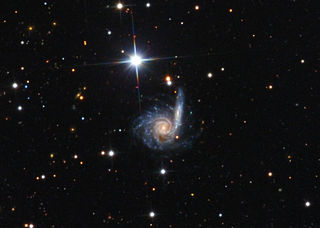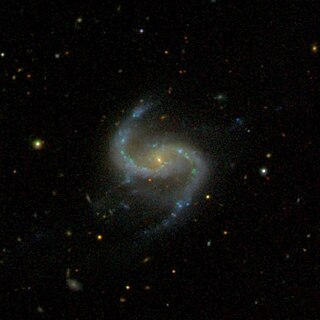
The Atlas of Peculiar Galaxies is a catalog of peculiar galaxies produced by Halton Arp in 1966. A total of 338 galaxies are presented in the atlas, which was originally published in 1966 by the California Institute of Technology. The primary goal of the catalog was to present photographs of examples of the different kinds of peculiar structures found among galaxies.

Arp 87 is a pair of interacting galaxies, NGC 3808A and NGC 3808B. They are situated in the Leo constellation. NGC 3808A, the brighter, is a peculiar spiral galaxy, while NGC 3808B is an irregular galaxy.

NGC 935 and IC 1801 are a pair of interacting galaxies within the Aries constellation. They were discovered on 18 September 1885 by Lewis Swift. NGC 935 is the northern member of the pair, and IC 1801 is the southern. Together, they are listed in Halton Arp's Atlas of Peculiar Galaxies as Arp 276, as an example of interacting galaxies.

NGC 14 is an irregular galaxy in the Pegasus constellation. It was included in Halton Arp's Atlas of Peculiar Galaxies, under the section "Galaxies with the appearance of fission," since the irregular appearance of this galaxy causes it to look like it is coming apart. It was discovered on September 18, 1786, by William Herschel.

Arp 273 is a pair of interacting galaxies, 300 million light years away in the constellation Andromeda. It was first described in the Atlas of Peculiar Galaxies, compiled by Halton Arp in 1966. The larger of the spiral galaxies, known as UGC 1810, is about five times more massive than the smaller galaxy. It has a disc that is tidally distorted into a rose-like shape by the gravitational pull of the companion galaxy below it, known as UGC 1813. The smaller galaxy shows distinct signs of active star formation at its nucleus, and "it is thought that the smaller galaxy has actually passed through the larger one."

Arp 7 is a spiral galaxy in the constellation Hydra. Redshift-independent measurements of its distance vary widely, from 5.9 Mpc to 83.7 Mpc. Its morphological classification is SB(rs)bc, meaning it is a barred spiral galaxy with some ring-like structure.

NGC 169 is a spiral galaxy located in the constellation Andromeda. It was discovered on September 18, 1857 by R. J. Mitchell.

NGC 497 is a barred spiral galaxy approximately 336 million light-years away from Earth in the constellation of Cetus. It was discovered by French astronomer Édouard Stephan on November 6, 1882.

NGC 6040 is a spiral galaxy located about 550 million light-years away in the constellation Hercules. NGC 6040 was discovered by astronomer Édouard Stephan on June 27, 1870. NGC 6040 is interacting with the lenticular galaxy PGC 56942. As a result of this interaction, NGC 6040's southern spiral arm has been warped in the direction toward PGC 56942. NGC 6040 and PGC 56942 are both members of the Hercules Cluster.

NGC 2300 is a lenticular galaxy in the constellation Cepheus. Its velocity with respect to the cosmic microwave background is 1876 ± 7 km/s, which corresponds to a Hubble distance of 90.2 ± 6.3 Mly (27.67 ± 1.94 Mpc). However, 11 non redshift measurements give a distance of 131.98 ± 21.75 Mly (40.464 ± 6.668 Mpc). The galaxy was discovered in 1871 by French astronomer Alphonse Borrelly using an 18 cm telescope.

NGC 7393 is a barred spiral galaxy in the constellation Aquarius. It is estimated to about 120 million light-years from the Milky Way and about 70,000 light-years in diameter. NGC 7393 belongs to the class of spiral galaxies with separated sections in the Arp catalog. Astronomer Halton Arp divided his catalog of unusual galaxies into groups based on purely morphological criteria. NGC 7393 was discovered by astronomer William Herschel on October 5, 1785.

UGC 1840, also known as Arp 145, are a pair of interacting galaxies located 250 million light-years away from the Solar System in the Andromeda constellation. The earliest known reference to the pair of galaxies is in part 2 of the Morphological Catalogue of Galaxies, published in 1964, where it is listed as MCG +07-06-002.

NGC 7829 is a lenticular galaxy in the constellation Cetus. NGC 7829 was discovered by American astronomer Francis Leavenworth in 1886. NGC 7829 forms with its neighbor NGC 7828 a pair of gravitationally interacting galaxies. The pair appears in Halton Arp's Atlas of Peculiar Galaxies as Arp 144.

NGC 5278 is a spiral galaxy in the constellation Ursa Major. It was discovered by German-British astronomer William Herschel in 1789.

NGC 3800 is an intermediate spiral galaxy located in the constellation Leo. Its speed relative to the cosmic microwave background is 3,653 ± 24 km/s, which corresponds to a Hubble distance of 53.9 ± 3.8 Mpc. NGC 3800 was discovered by German-British astronomer William Herschel in 1784.

NGC 3799 is a barred spiral galaxy located in the constellation Leo. Its speed relative to the cosmic microwave background is 3,659 ± 24 km/s, which corresponds to a Hubble distance of 54.0 ± 3.8 Mpc. NGC 3799 was discovered by British astronomer John Herschel in 1832.

NGC 6365 is a pair of spiral galaxies in the constellation Draco. It consists of two galaxies, PGC 60174 to the south, and PGC 60171 to the north. These two galaxies are also designated respectively by the NASA/IPAC database as NGC 6365A and NGC 6365B. This pair of galaxies was discovered by German astronomer Lewis Swift in 1884.

NGC 4017 is an intermediate spiral radio galaxy located in the constellation Coma Berenices. Its speed relative to the cosmic microwave background is 3,748 ± 21 km/s, which corresponds to a Hubble distance of 55.3 ± 3.9 Mpc. NGC 4017 was discovered by German-British astronomer William Herschel in 1785.

NGC 2937 is an elliptical galaxy located in the constellation Hydra. Its velocity relative to the cosmic microwave background is 105.1 ± 7.4 km/s, which corresponds to a Hubble distance of 105.1 ± 7.4 Mpc. NGC 2937 was discovered by German astronomer Albert Marth in 1864.

NGC 5394 is a barred spiral galaxy located in the constellation Canes Venatici. Its speed relative to the cosmic microwave background is 3,639 ± 14 km/s, which corresponds to a Hubble distance of 53.7 ± 3.8 Mpc. NGC 5394 was discovered by German-British astronomer William Herschel in 1787.




















